How to Create an Effective Customer Journey Map 

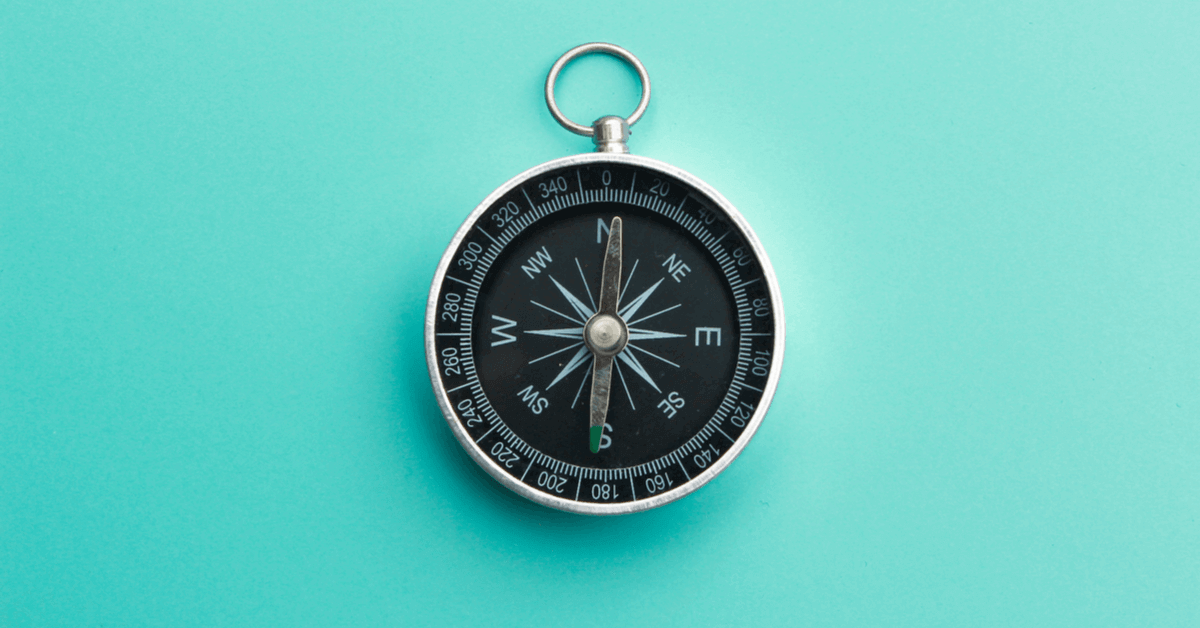
Whether you’re looking to recruit new customers or boost loyalty with your existing customers, it all starts with the same thing: getting to know your customers.
You might have a killer product that blows the competition out of the water. But unless you can reach your customers at the right time with the right message, you’ll never see the gains you deserve from your digital marketing campaigns.
That’s where having a customer journey map comes in.
A customer journey map can be the difference between shooting blindly with your ads and delivering a laser-focused message that hits right on the money — and that makes you more money.
With this vital tool, you’ll figure out key touch points for each buyer persona and get a clear idea of how they move from awareness to consideration, conversion, and advocacy.
So how do you go about building customer journeys that accurately describes a person’s experience at every stage of the marketing funnel?
Keep reading to find out.
- What is a customer journey map
- Types of customer journey maps
- How to create a customer journey map
- Customer journey map best practices
- Ways customer journey maps benefit organisations
- 3 customer journey mapping examples to learn from
- Free customer journey map templates to use
What is a customer journey map?
A customer journey map is a visual representation of the process that a person encounters as they go through the different stages of the buyer funnel with your company.
Customer journeys reveal the big picture of how customers interact with your brand across multiple touchpoints to reach an end goal, such as signing up for your newsletter, making a purchase, or filling out your contact form.
What’s included in a customer journey map?
Every customer journey map should include key milestones that a person reaches before getting to the final goal of conversion. At the very least, your map should include considerations on:
- The buyer persona: Who is the average customer going through the journey? The customer journey can be dramatically different depending on the type of customers you’re shooting for, so aim to create one customer journey map for each buyer persona.
- Phases of the journey: Think of the different phases of the journey like chapters that progress along a narrative towards the ultimate goal. These phases might be broken down into the basic buyer funnel — awareness, engagement, consideration, conversion and advocacy — or something that’s more tailored to your business, such as discover, try, buy and use.
- User actions: This section of your map should include the main actions that a customer takes during that phase of the journey. For example, they might run a Google search for your company during the awareness stage, then read reviews about your business during the consideration phase. Getting to know the key actions a user takes is a powerful way to put yourself in their shoes and provide them with the right message in the right place.
- Channels: On top of listing the actions your user takes, customer journey maps should also reveal where these actions are occurring. Is it on social media? Do they talk to friends and family? Visit your website? Nutting out the channels can help you figure out where to focus your efforts across your different platforms.
- Emotion and mindset: How are your customers feeling at every phase? What are the problems they’re looking to solve and what’s the mindset they’re in when they’re at this stage? This information helps you create tailored messaging that speaks to them throughout their journey and move them further along the process.
What is a touchpoint in a customer journey map?
Touchpoints are any point in your customer journeys where a prospect or customer interacts with your business. These can be anything from digital marketing channels, such as your social media accounts, PPC Ads or your website content, to physical touchpoints like a brick-and-mortar store, or customers interacting with members of your team via a chatbot or customer service hotline.
It’s important to pay attention to these touchpoints because they’re make-or-break moments in the customer experience.
For example, let’s say a prospective customer has learned about your products and wants to get to know more about your brand. They run a Google search for your company and find a few negative reviews, which may deter them from moving forward in their path to conversion.
On the other hand, another prospect finds out about your products via an influencer’s social media account, then clicks on your profile to learn more about your business. They engage with your chatbot, which directs them to the information they’re looking for, and ultimately makes a purchase.
These two examples illustrate just how important touchpoints are to your customer journey map. When you identify the different points of interaction that a customer has with your brand, you’ll be able to pinpoint opportunities to improve upon their customer experience at every phase of the journey.
Journey Map vs. Experience Map
While you’re doing your research on customer journey maps, you might also come across experience maps. This is another handy tool that you can use to get a better understanding of your target audience, particularly when used together with a journey map.
The main difference between a customer journey map and a customer experience map is that one (the journey map) focuses on a customer’s journey with a specific product or service, whereas the other (the experience map) speaks to broader human experiences and behaviours.
The experience map is a great way to identify different pain points or challenges in a customer’s life, which can then be used to inform a future customer journey map.
Types of customer journey maps
1. Current State Journey Mapping
This is the most popular form of customer journey mapping, and for good reason. This user journey map describes the actions and emotions that potential customers experience as they’re interacting with your brand at different touchpoints. Current state journey mapping is effective if you want to understand a person’s experience with your brand and figure out where there’s room to improve.
2. Future State Journey Mapping
Future state mapping visualises the actions and experiences customers will have with your company in the future. This type of journey mapping can be used to plan ahead, set clear customer-centric goals, and demonstrate how your business strategy will impact the customer journey in the future.
3. Day in the Life Mapping
A Day in the Life map describes the actions and emotions that your customer experiences, as well as the touchpoints they encounter in their daily activities — with or without your company.
This type of customer journey map helps you step into the shoes of your audience and pinpoint any unaddressed pain point that they might experience throughout their day. With this information, you’ll be able to explore new features to your service or introduce new products to meet your customer needs.
4. Service Blueprint
A service blueprint map speaks specifically to the different service touchpoints at each phase of the customer journey. These maps are typically overlaid over a simplified version of another map type, such as the current state journey map, and outline the processes, technologies, and people that the customer encounters at each stage.
Service blueprints are helpful if you want to identify the causes behind your current customer journey or identify which steps you need to take to improve the journey in the future.
5. Circular
Circular customer journey maps are invaluable if you’re running a subscription-based business or if you want to put a strong emphasis on customer loyalty and retention. These maps visualise the customer journey as a cycle, which typically covers the actions and touchpoints a customer encounters before, during, and after they make a purchase with your company.
6. Empathy Map
Empathy maps reveal what a customer does, thinks, feels, says and hears during their interactions with your brand. These maps are handy if you want to gain a deeper shared understanding of how customers feel and use this to shape better customer experiences.
How to create a customer journey map
1. Define your goals
Before you start mapping out your key touchpoints and channels, you need to get clear on your objectives. There are two parts to this:
- understanding what your goals are with the customer journey map, and
- setting out which user experiences your map will address
Let’s start by looking at the first one.
Unless you have a clear understanding of how you’re going to use the customer journey map, you won’t see it delivering a tangible impact on your business.
You need to define who is going to use this tool within your organisation, as well as the information that will be most beneficial to them and how they’ll apply it.
Once you know this, it’s time to define which user experiences you want to address. Identify the key scenarios you want to delve into with your map, and the buyer personas you want to focus on.
Don’t forget — you can always add maps for multiple personas and scenarios in the future.
2. Conduct user research into your buyer personas
Your buyer personas are at the heart of any customer journey map. That’s why you need to spend as much time as possible fleshing out exactly who they are, from their main goals to their challenges and pain points.
While you may already have a few buyer personas under your sleeve, this is the perfect opportunity to build on those further with actual customer research. You can do this in any number of ways, including:
- Survey customers to get their first-hand feedback
- Using the Net Promoter Score feedback tool
- Conduct 1-on-1 user interviews with your existing customer base
- Speaking to team members who regularly interact with your customers, such as sales reps or community managers
- Listening to real customers’ calls and reviewing customer support logs
- Monitoring discussions about your company online
- Diving into your web analytics and/or heat mapping tools to conduct research into user behaviour
Take these learnings and use them to build or update each target persona. Focus on crucial moments in the customer journey, such as:
- When and how customers discovered your brand
- What drew them to your brand and your products or services
- What the deciding factor was that caused them to make a purchase
- Any pain points they had throughout their experience
- How easy they found it to find information
- Their overall experience with your website
3. Identify key touchpoints along the customer journey
Once you’ve gathered your customer insights and defined the buyer personas for your customer journey mapping, it’s time to move into the next step: listing out their key touchpoints.
Touchpoints are all of the different platforms and places where your customer interactions take place with your brand. These touchpoints will form the bulk of your map, because they’re the moments where a user takes an action and either has a positive experience and moves further along the funnel or decides to bring their business elsewhere.
Start by listing all of your customer touchpoints, both online and offline. These might include:
- Your website
- Social media channels
- Paid advertising
- Organic search
- Email marketing
- Third-party websites or mentions
- PR
- Physical stores
- Customer support hotlines or chatbots
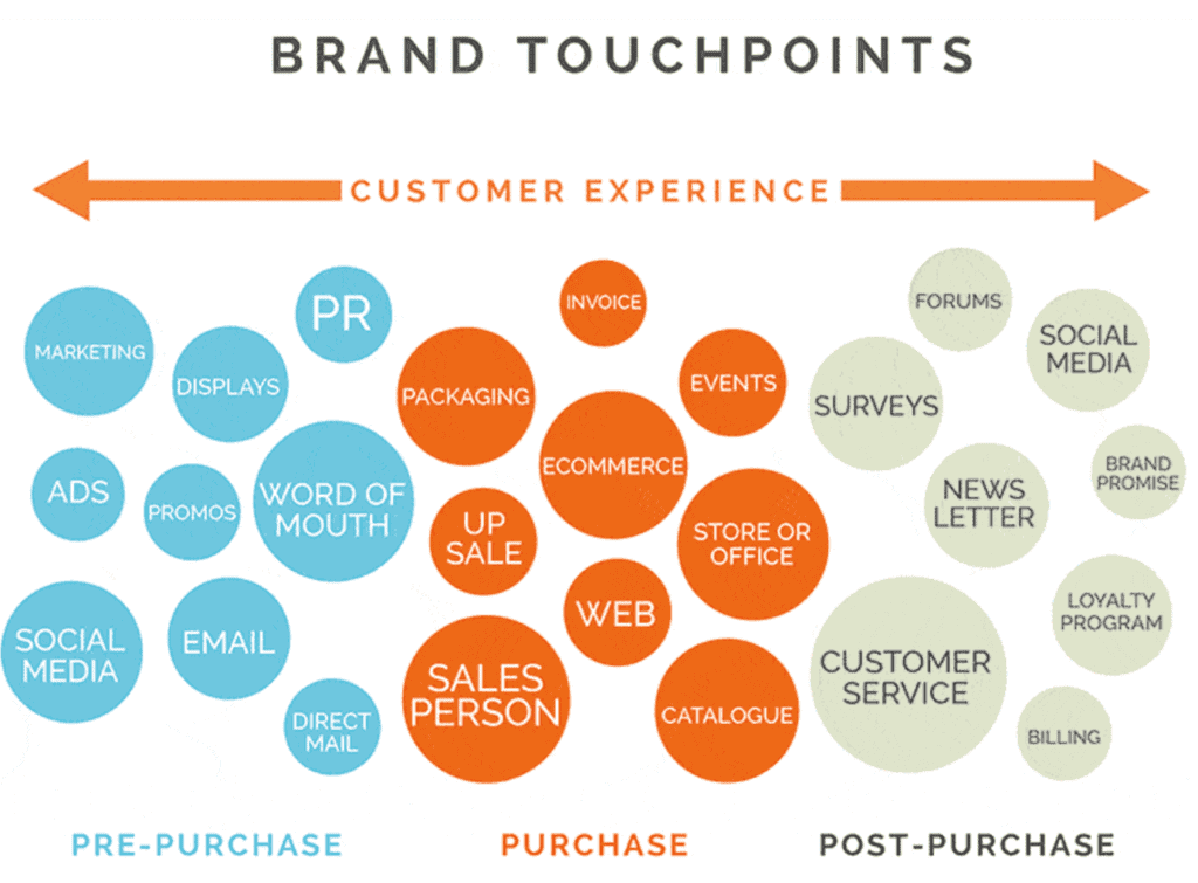
Image source: Sentisum
From here, pick out the touchpoints that most accurately reflect a person’s experience with your brand. For example, if most of your customers learn and engage with your brand on social media, this might be one of the key touchpoints you focus on.
4. Build a customer journey for each of your customer personas
After you’ve identified the main touchpoints in your buyer funnel, you can start to create a customer journey map.
Plot your touchpoints out in the order that customers are most likely to go through when discovering and engaging with your brand.
For some companies, this might start out with a Google search, followed by a website visit and newsletter sign-up. For others, it might start with social media and then move to your website and a physical shopfront.
Under each touchpoint, list:
- the actions that a customer might take during that interaction, such as navigating to your About Us page or sending a message to your company
- the emotional drivers that a customer experiences at each touchpoint
- any blocking points or obstacles that may get in the way of your customer moving to the next phase, like abandoning their cart because their preferred payment method isn’t available or leaving your website because it took too long to load.
Take time to really put your customer’s journey under the microscope. This exercise helps to identify gaps as they interact with your brand, or pinpoint opportunities to strengthen their experience.
5. Share your finished map
It’s not just enough to build a customer journey map and keep it to yourself.
You need to distribute this shared vision with other members of your team if you want to create maximum impact and deliver an exceptional customer experience.
You may get additional insights that you wouldn’t have had otherwise, such as questions that customers might ask a sales rep during a call, or common complaints that your support team receives.
What’s more, you can all work together to identify where your company can do better.
Share your journey maps with key stakeholders, and work together to identify key areas of improvement.
Ask questions like:
- Are we missing any key touchpoints that could be included?
- Where are we falling short of expectations?
- Are we addressing all of our customer’s needs?
- Is there any area where we can do better?
- Can we reduce the number of actions a user needs to take with any given interaction?
Use this information to create a roadmap of changes that need to be implemented to enhance the customer experience.
6. Regularly review and update your journey maps
Your customer’s experience with your brand is always evolving, and your customer journey map should be too.
At the very least, you should be reviewing your customer journey map once every quarter. However, you should also undertake the journey mapping process again any time you make a major change to your business, such as launching a new digital marketing channel, introducing a new product or service, or setting up a chatbot.
Customer journey map best practices
Use data to inform your journey maps
It’s all too common for business owners and marketers to assume they know their customers inside-out. Unfortunately, this can lead to blind spots within the customer journey map that never get identified or addressed.
That’s why it’s best to incorporate real customer insights and data that backs up every interaction along the customer journey, whether it’s from a survey, web analytics, chat logs, or other tools.
Create a separate map for each buyer persona
Customers don’t behave in the same way.
Let’s say you’re running a B2B SaaS company that’s made for professional teams. The way a junior employee discovers and interacts with your brand could be completely different from a senior executive. If you don’t account for this when you create customer journey maps, you’ll wind up with a confusing collection of charts that don’t capture any one customer’s actual experience with your brand.
Start out with a couple of buyer personas that represent your core target audience, and build one to two customer journeys for these personas.
Make it accessible
Customer journey maps aren’t just helpful for marketing teams.
They’re an incredibly handy tool for everyone across the business, from sales, operations, customer service, product development, and senior leaders.
Make your map accessible by:
- designing it using a visually appealing template that’s clear and easy to understand
- including statements that sum up the customer’s emotions at different stages of the journey (i.e. “I want to improve efficiency within my team” or “Does this product really do what it promises?”).
- sharing it with key stakeholders via a common platform, like Google Drive or a cloud-based chart tool
Ways customer journey maps benefit organisations
Customer journey mapping is incredibly beneficial for all companies, from B2C to B2B, and from start-ups to global enterprises.
Here are three compelling reasons why breaking down the customer journey map into a clear, visual process can help your entire organization succeed in the short and long term:
- It helps you improve upon the customer experience. This is invaluable, given that 8 in 10 customers say they consider their experience with a company to be as important as the products that the company sells.
- Improve customer retention and loyalty. Customer journey maps are a great way to address moments where your customers might be vulnerable to churn. Over time, this leads to more revenue and ROI, as the cost of winning a new customer can be anywhere from 5 to 25 times more expensive than retaining an existing customer.
- Build a customer-centric mindset. When you focus on the customer journey, you flip your thinking from outbound marketing (“how can I reach my customers?”) to inbound marketing (“how can I solve my customer’s problems and address their pain points?”). And, given inbound is 10x more effective for lead conversion than outbound, you’ll inevitably see the payoff in your bottom line as well.
3 customer journey mapping examples to learn from
Rail Europe’s Customer Journey Map
This complex multi-channel journey map is dense but packed with useful information to help cross-functional teams improve the Rail Europe experience. Each phase is clearly outlined, along with the key actions a customer is taking, the main considerations going through their mind, any pain points, and their emotions at every stage of the journey.
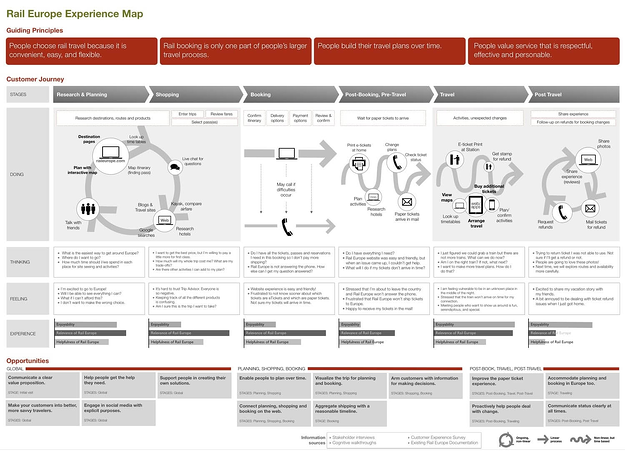
WCIG’s Customer Journey Map
Like Rail Europe, WCIG’s map is extremely busy. However, the visual illustration of this customer journey map example makes it easy for anyone in the team to step into the customer’s shoes and understand the path they take to move on to the next stage in their journey.
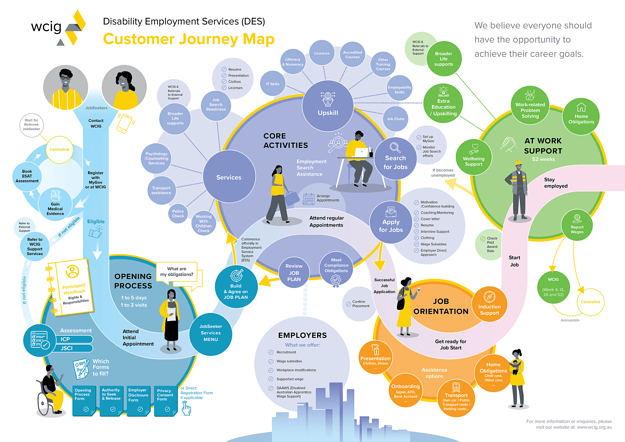
Bright Vessel’s Future Customer Journey Map
In this customer journey map example, Carnegie Melon University has plotted out future interactions for a new student arriving in their school.
The map is powerful because it maps a customer’s actions and emotional state of mind, touchpoints, scenarios, and proposed changes within a set journey timeframe from admission to campus arrival.
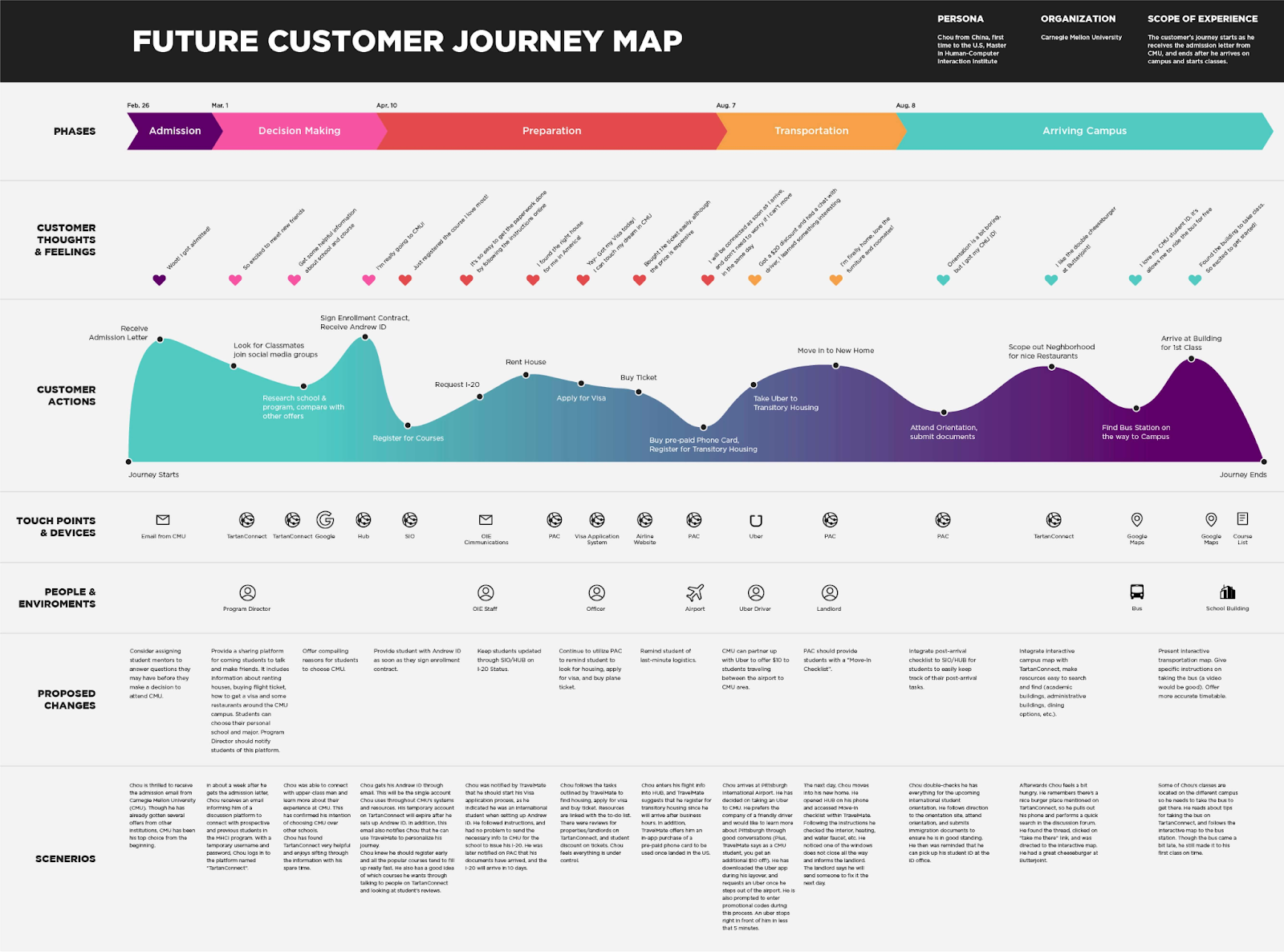
Free customer journey map templates to use
Basic Customer Journey Map Templates
HubSpot’s free editable templates are fantastic tools to help you put together your first customer journey map. The Buyer’s Journey template covers the three stages of the customer journey — awareness, consideration and conversion — and asks key questions to guide the mapping process.
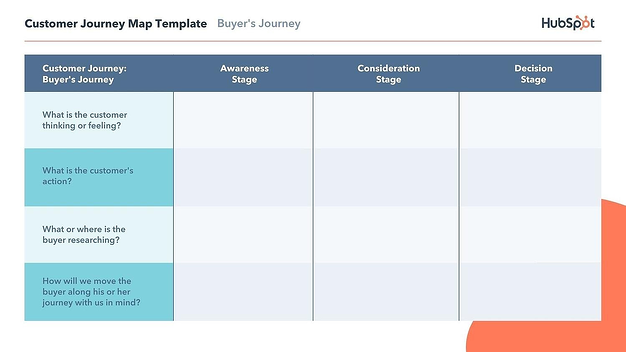
HubSpot also has a B2B version for lead nurturing:
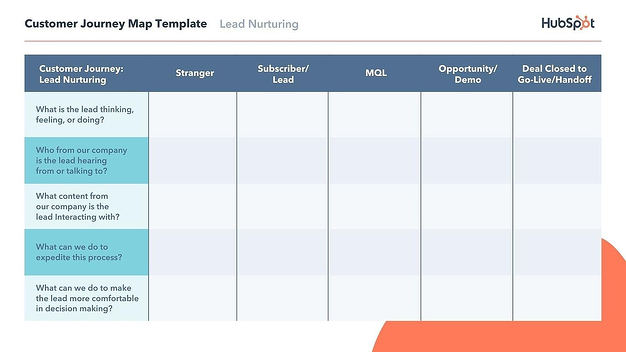
eCommerce customer journey map example
As well as having the main user actions and touchpoints, this free template encourages you to map a customer’s emotions at each stage of the process, as well as any existing pain points and possible solutions the company can take to address these.
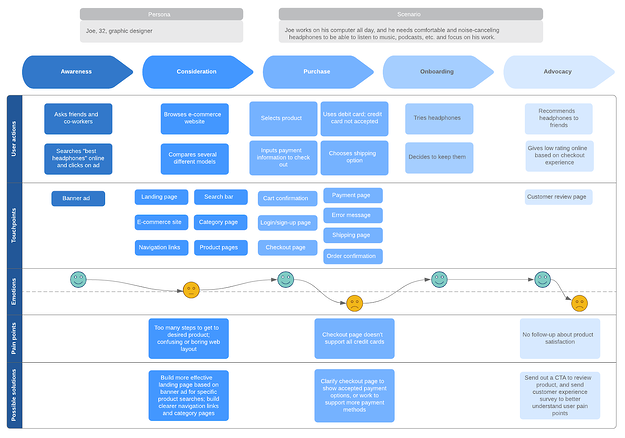
Circular customer journey map template
This diagram visualises the user journey as a loop, which starts with a specific need and then moves into consideration, customer engagement, evaluation, purchase and usage. The beneficial thing about this template is that it helps connect the dots between a customer using your product and their next purchase or renewal.
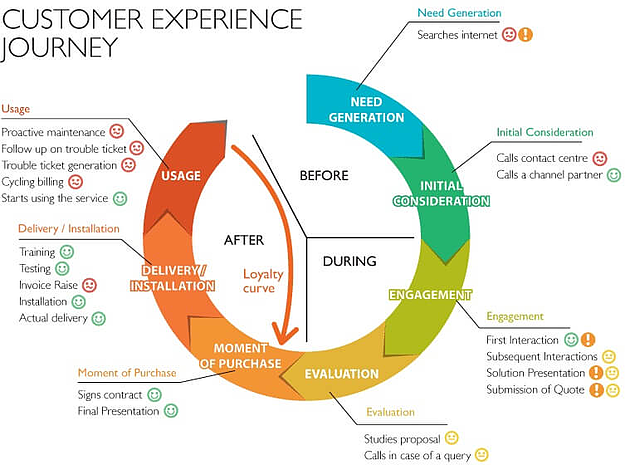
Service blueprint template
This template works well if you want to understand all of the different processes that take place during the customer journey, including front-end employee actions, back-stage actions, and supporting processes like automated emails or third-party deliveries.
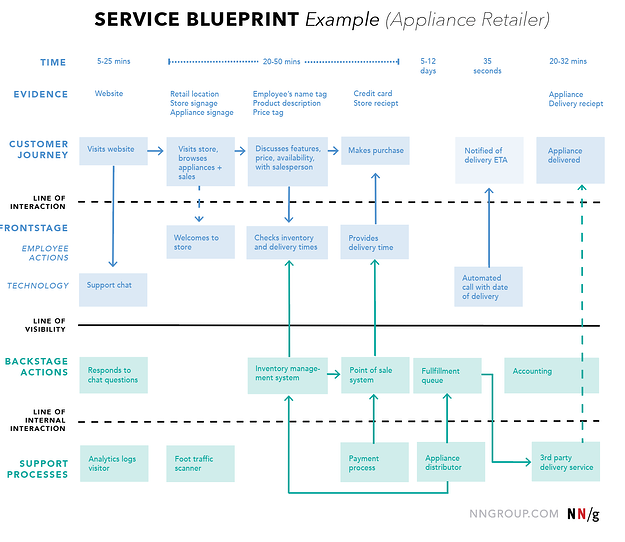
Getting to know your customers
Customer journey mapping is the first step in connecting to your target audience and driving them to convert. But getting to know your audience is only one part of the equation.
Now that you have your map, you need to reach your customers and ensure that you’re delivering an out-of-this-world experience across all digital touchpoints.
With our evidence-based approach and digital marketing expertise, we’ll work with you to unlock the power of your customer journey map for insane digital marketing ROI.
Ready to get started?
Claim your FREE audit today and we’ll tell you how your business is performing across all of your digital channels. Then we’ll engineer a tailored 12-month game plan to skyrocket your revenue and improve your customer’s experience online.









